The Importance of Critical Thinking in Higher Learning Institutions
VerifiedAdded on 2020/03/01
|6
|1450
|61
Essay
AI Summary
This essay examines the concept and significance of critical thinking in higher learning institutions. It defines critical thinking as the application of high-order cognitive skills and decision-making abilities, emphasizing its importance in academic and professional settings. The essay explores various methods for fostering critical thinking, including problem-solving approaches such as comparison and classification, peer learning through group discussions, and creating an enhanced learning environment. It highlights the importance of encouraging critical, reflective thinking and providing opportunities for students to engage in discussions and question concepts. The essay concludes by stressing the need for institutions to prioritize critical thinking in their curricula and the role of instructors in facilitating this process through professional development and thoughtful instruction.
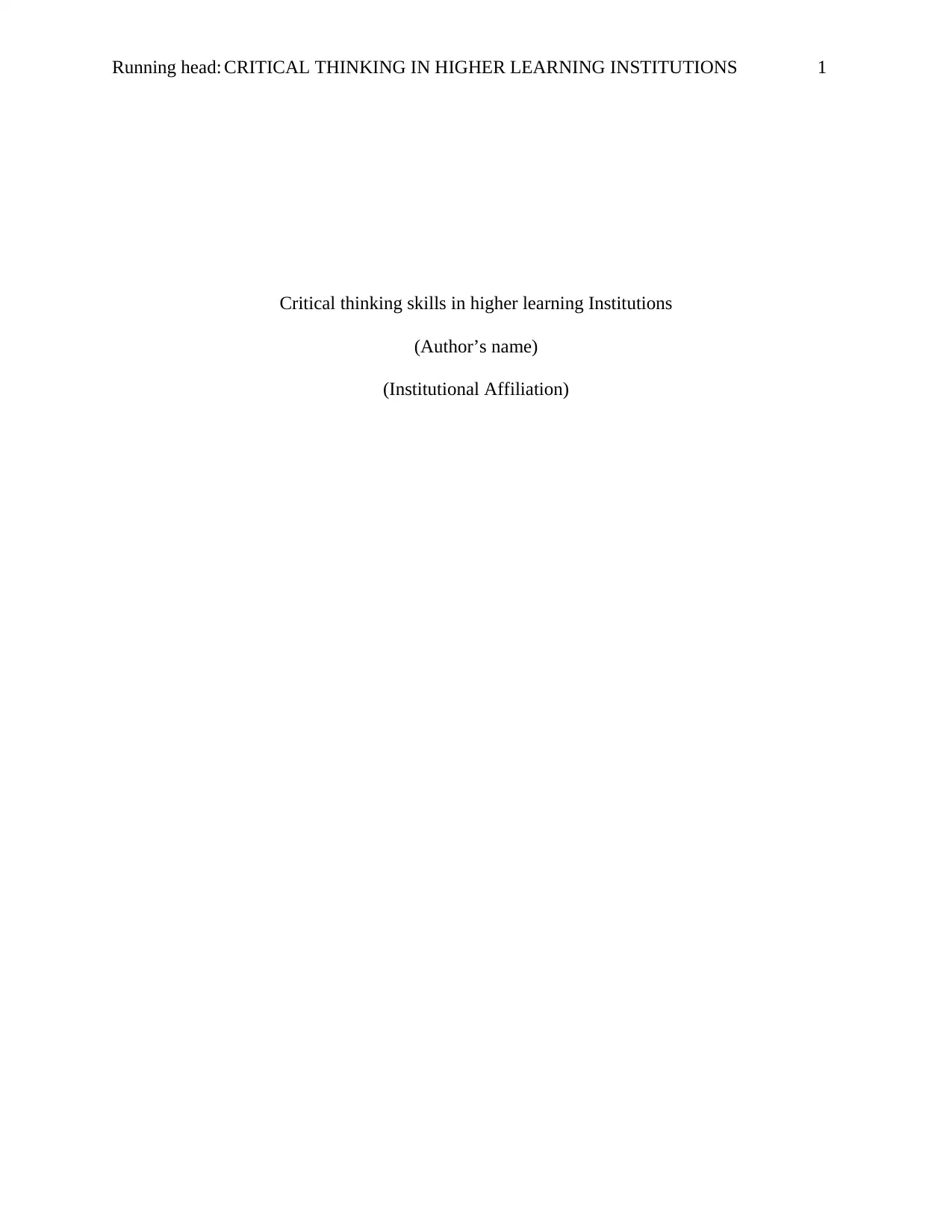
Running head: CRITICAL THINKING IN HIGHER LEARNING INSTITUTIONS 1
Critical thinking skills in higher learning Institutions
(Author’s name)
(Institutional Affiliation)
Critical thinking skills in higher learning Institutions
(Author’s name)
(Institutional Affiliation)
Paraphrase This Document
Need a fresh take? Get an instant paraphrase of this document with our AI Paraphraser
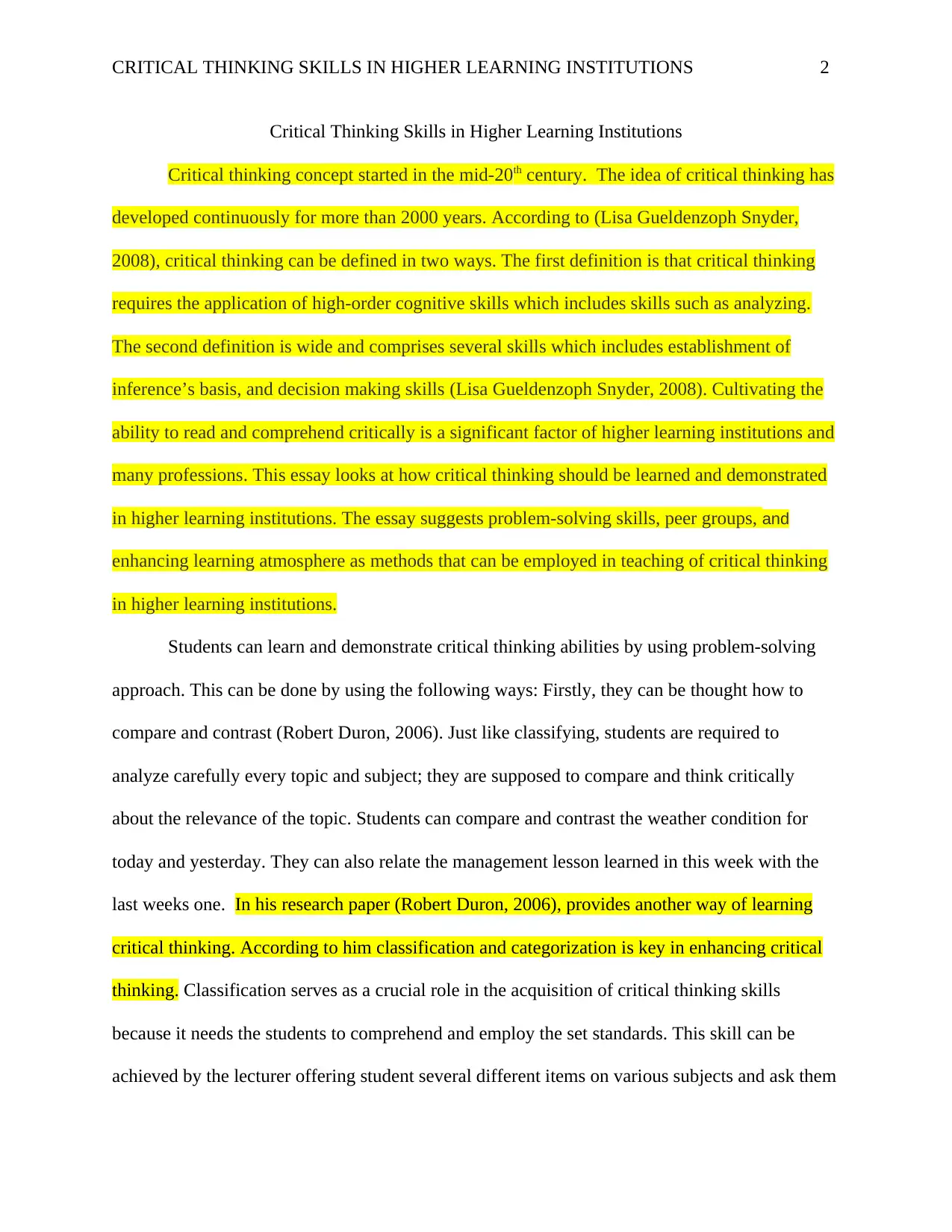
CRITICAL THINKING SKILLS IN HIGHER LEARNING INSTITUTIONS 2
Critical Thinking Skills in Higher Learning Institutions
Critical thinking concept started in the mid-20th century. The idea of critical thinking has
developed continuously for more than 2000 years. According to (Lisa Gueldenzoph Snyder,
2008), critical thinking can be defined in two ways. The first definition is that critical thinking
requires the application of high-order cognitive skills which includes skills such as analyzing.
The second definition is wide and comprises several skills which includes establishment of
inference’s basis, and decision making skills (Lisa Gueldenzoph Snyder, 2008). Cultivating the
ability to read and comprehend critically is a significant factor of higher learning institutions and
many professions. This essay looks at how critical thinking should be learned and demonstrated
in higher learning institutions. The essay suggests problem-solving skills, peer groups, and
enhancing learning atmosphere as methods that can be employed in teaching of critical thinking
in higher learning institutions.
Students can learn and demonstrate critical thinking abilities by using problem-solving
approach. This can be done by using the following ways: Firstly, they can be thought how to
compare and contrast (Robert Duron, 2006). Just like classifying, students are required to
analyze carefully every topic and subject; they are supposed to compare and think critically
about the relevance of the topic. Students can compare and contrast the weather condition for
today and yesterday. They can also relate the management lesson learned in this week with the
last weeks one. In his research paper (Robert Duron, 2006), provides another way of learning
critical thinking. According to him classification and categorization is key in enhancing critical
thinking. Classification serves as a crucial role in the acquisition of critical thinking skills
because it needs the students to comprehend and employ the set standards. This skill can be
achieved by the lecturer offering student several different items on various subjects and ask them
Critical Thinking Skills in Higher Learning Institutions
Critical thinking concept started in the mid-20th century. The idea of critical thinking has
developed continuously for more than 2000 years. According to (Lisa Gueldenzoph Snyder,
2008), critical thinking can be defined in two ways. The first definition is that critical thinking
requires the application of high-order cognitive skills which includes skills such as analyzing.
The second definition is wide and comprises several skills which includes establishment of
inference’s basis, and decision making skills (Lisa Gueldenzoph Snyder, 2008). Cultivating the
ability to read and comprehend critically is a significant factor of higher learning institutions and
many professions. This essay looks at how critical thinking should be learned and demonstrated
in higher learning institutions. The essay suggests problem-solving skills, peer groups, and
enhancing learning atmosphere as methods that can be employed in teaching of critical thinking
in higher learning institutions.
Students can learn and demonstrate critical thinking abilities by using problem-solving
approach. This can be done by using the following ways: Firstly, they can be thought how to
compare and contrast (Robert Duron, 2006). Just like classifying, students are required to
analyze carefully every topic and subject; they are supposed to compare and think critically
about the relevance of the topic. Students can compare and contrast the weather condition for
today and yesterday. They can also relate the management lesson learned in this week with the
last weeks one. In his research paper (Robert Duron, 2006), provides another way of learning
critical thinking. According to him classification and categorization is key in enhancing critical
thinking. Classification serves as a crucial role in the acquisition of critical thinking skills
because it needs the students to comprehend and employ the set standards. This skill can be
achieved by the lecturer offering student several different items on various subjects and ask them
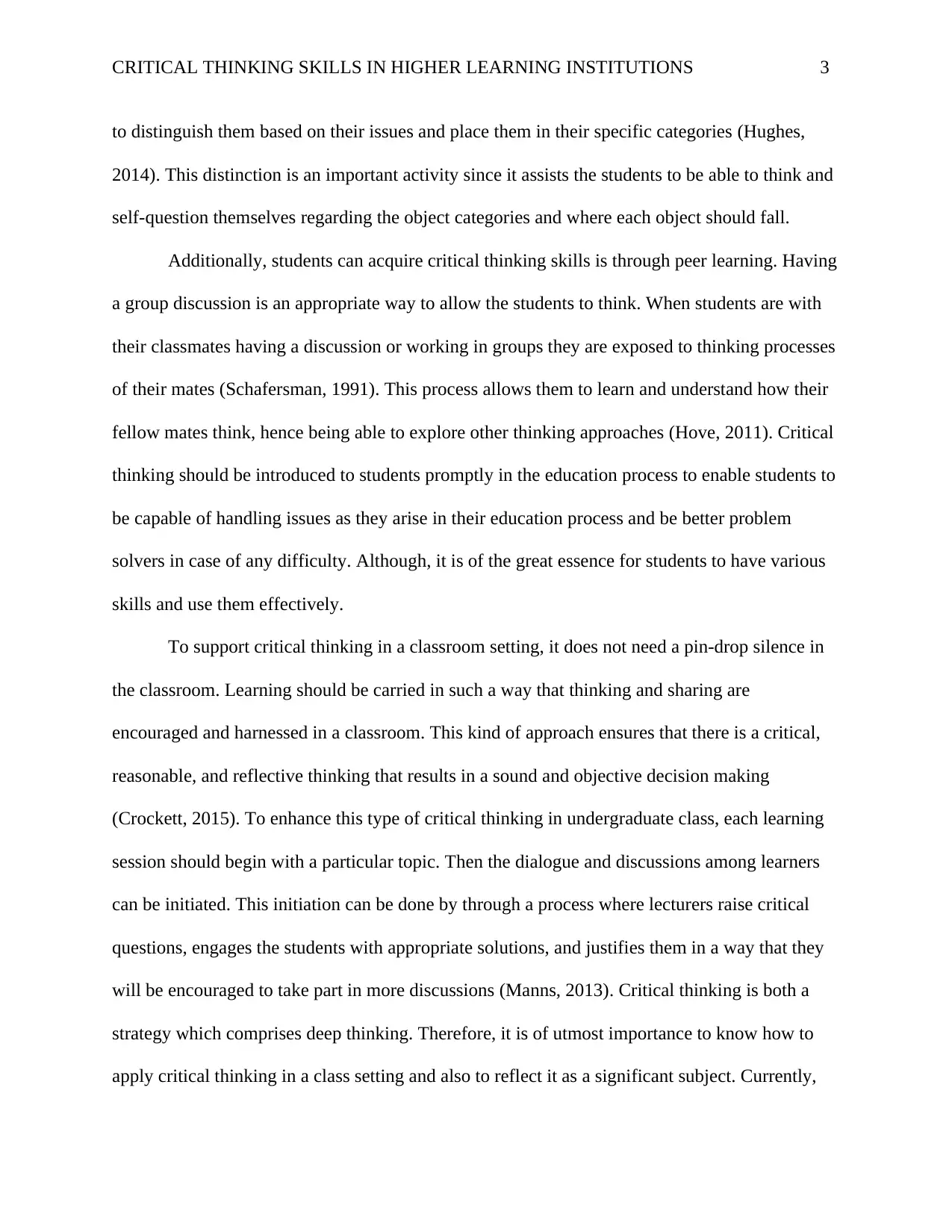
CRITICAL THINKING SKILLS IN HIGHER LEARNING INSTITUTIONS 3
to distinguish them based on their issues and place them in their specific categories (Hughes,
2014). This distinction is an important activity since it assists the students to be able to think and
self-question themselves regarding the object categories and where each object should fall.
Additionally, students can acquire critical thinking skills is through peer learning. Having
a group discussion is an appropriate way to allow the students to think. When students are with
their classmates having a discussion or working in groups they are exposed to thinking processes
of their mates (Schafersman, 1991). This process allows them to learn and understand how their
fellow mates think, hence being able to explore other thinking approaches (Hove, 2011). Critical
thinking should be introduced to students promptly in the education process to enable students to
be capable of handling issues as they arise in their education process and be better problem
solvers in case of any difficulty. Although, it is of the great essence for students to have various
skills and use them effectively.
To support critical thinking in a classroom setting, it does not need a pin-drop silence in
the classroom. Learning should be carried in such a way that thinking and sharing are
encouraged and harnessed in a classroom. This kind of approach ensures that there is a critical,
reasonable, and reflective thinking that results in a sound and objective decision making
(Crockett, 2015). To enhance this type of critical thinking in undergraduate class, each learning
session should begin with a particular topic. Then the dialogue and discussions among learners
can be initiated. This initiation can be done by through a process where lecturers raise critical
questions, engages the students with appropriate solutions, and justifies them in a way that they
will be encouraged to take part in more discussions (Manns, 2013). Critical thinking is both a
strategy which comprises deep thinking. Therefore, it is of utmost importance to know how to
apply critical thinking in a class setting and also to reflect it as a significant subject. Currently,
to distinguish them based on their issues and place them in their specific categories (Hughes,
2014). This distinction is an important activity since it assists the students to be able to think and
self-question themselves regarding the object categories and where each object should fall.
Additionally, students can acquire critical thinking skills is through peer learning. Having
a group discussion is an appropriate way to allow the students to think. When students are with
their classmates having a discussion or working in groups they are exposed to thinking processes
of their mates (Schafersman, 1991). This process allows them to learn and understand how their
fellow mates think, hence being able to explore other thinking approaches (Hove, 2011). Critical
thinking should be introduced to students promptly in the education process to enable students to
be capable of handling issues as they arise in their education process and be better problem
solvers in case of any difficulty. Although, it is of the great essence for students to have various
skills and use them effectively.
To support critical thinking in a classroom setting, it does not need a pin-drop silence in
the classroom. Learning should be carried in such a way that thinking and sharing are
encouraged and harnessed in a classroom. This kind of approach ensures that there is a critical,
reasonable, and reflective thinking that results in a sound and objective decision making
(Crockett, 2015). To enhance this type of critical thinking in undergraduate class, each learning
session should begin with a particular topic. Then the dialogue and discussions among learners
can be initiated. This initiation can be done by through a process where lecturers raise critical
questions, engages the students with appropriate solutions, and justifies them in a way that they
will be encouraged to take part in more discussions (Manns, 2013). Critical thinking is both a
strategy which comprises deep thinking. Therefore, it is of utmost importance to know how to
apply critical thinking in a class setting and also to reflect it as a significant subject. Currently,
⊘ This is a preview!⊘
Do you want full access?
Subscribe today to unlock all pages.

Trusted by 1+ million students worldwide
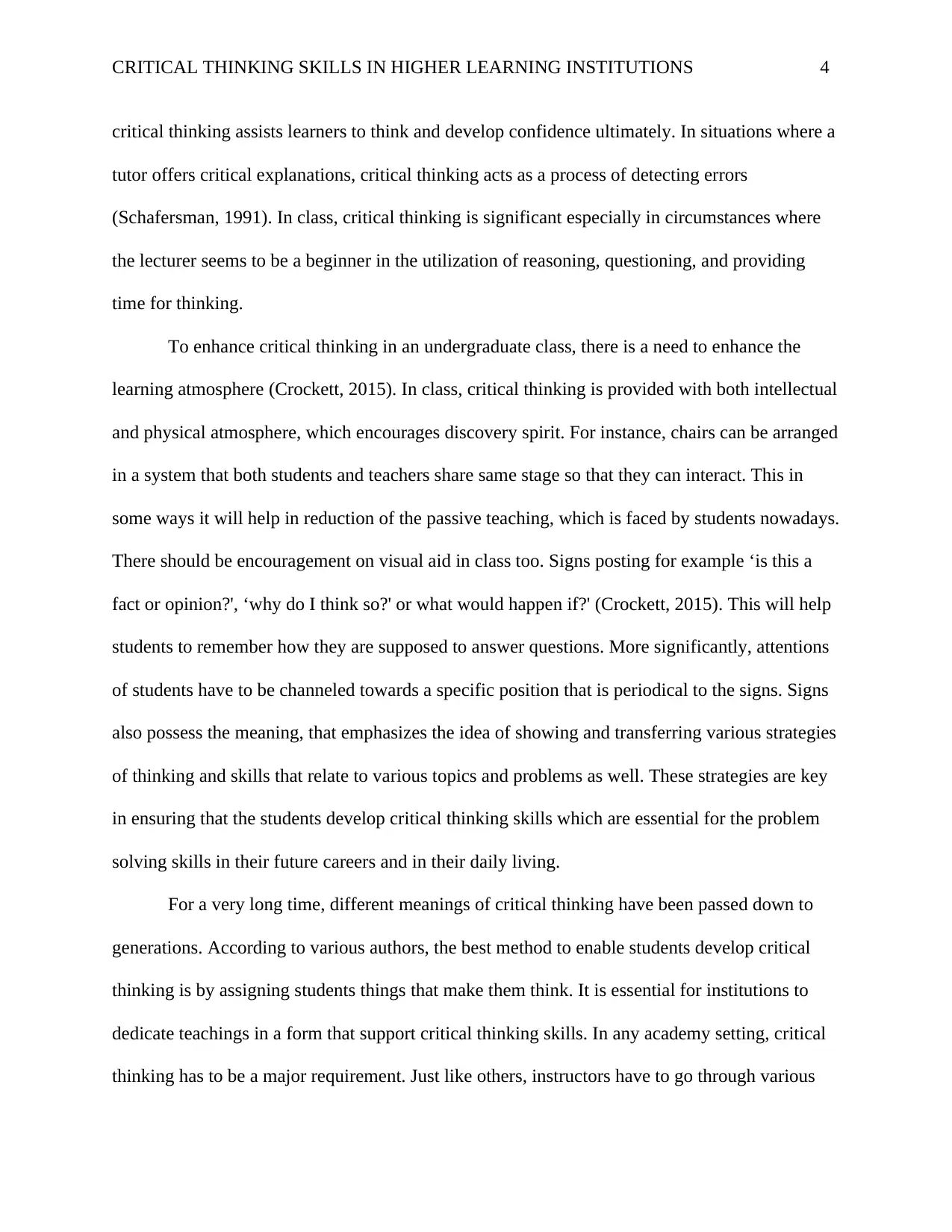
CRITICAL THINKING SKILLS IN HIGHER LEARNING INSTITUTIONS 4
critical thinking assists learners to think and develop confidence ultimately. In situations where a
tutor offers critical explanations, critical thinking acts as a process of detecting errors
(Schafersman, 1991). In class, critical thinking is significant especially in circumstances where
the lecturer seems to be a beginner in the utilization of reasoning, questioning, and providing
time for thinking.
To enhance critical thinking in an undergraduate class, there is a need to enhance the
learning atmosphere (Crockett, 2015). In class, critical thinking is provided with both intellectual
and physical atmosphere, which encourages discovery spirit. For instance, chairs can be arranged
in a system that both students and teachers share same stage so that they can interact. This in
some ways it will help in reduction of the passive teaching, which is faced by students nowadays.
There should be encouragement on visual aid in class too. Signs posting for example ‘is this a
fact or opinion?', ‘why do I think so?' or what would happen if?' (Crockett, 2015). This will help
students to remember how they are supposed to answer questions. More significantly, attentions
of students have to be channeled towards a specific position that is periodical to the signs. Signs
also possess the meaning, that emphasizes the idea of showing and transferring various strategies
of thinking and skills that relate to various topics and problems as well. These strategies are key
in ensuring that the students develop critical thinking skills which are essential for the problem
solving skills in their future careers and in their daily living.
For a very long time, different meanings of critical thinking have been passed down to
generations. According to various authors, the best method to enable students develop critical
thinking is by assigning students things that make them think. It is essential for institutions to
dedicate teachings in a form that support critical thinking skills. In any academy setting, critical
thinking has to be a major requirement. Just like others, instructors have to go through various
critical thinking assists learners to think and develop confidence ultimately. In situations where a
tutor offers critical explanations, critical thinking acts as a process of detecting errors
(Schafersman, 1991). In class, critical thinking is significant especially in circumstances where
the lecturer seems to be a beginner in the utilization of reasoning, questioning, and providing
time for thinking.
To enhance critical thinking in an undergraduate class, there is a need to enhance the
learning atmosphere (Crockett, 2015). In class, critical thinking is provided with both intellectual
and physical atmosphere, which encourages discovery spirit. For instance, chairs can be arranged
in a system that both students and teachers share same stage so that they can interact. This in
some ways it will help in reduction of the passive teaching, which is faced by students nowadays.
There should be encouragement on visual aid in class too. Signs posting for example ‘is this a
fact or opinion?', ‘why do I think so?' or what would happen if?' (Crockett, 2015). This will help
students to remember how they are supposed to answer questions. More significantly, attentions
of students have to be channeled towards a specific position that is periodical to the signs. Signs
also possess the meaning, that emphasizes the idea of showing and transferring various strategies
of thinking and skills that relate to various topics and problems as well. These strategies are key
in ensuring that the students develop critical thinking skills which are essential for the problem
solving skills in their future careers and in their daily living.
For a very long time, different meanings of critical thinking have been passed down to
generations. According to various authors, the best method to enable students develop critical
thinking is by assigning students things that make them think. It is essential for institutions to
dedicate teachings in a form that support critical thinking skills. In any academy setting, critical
thinking has to be a major requirement. Just like others, instructors have to go through various
Paraphrase This Document
Need a fresh take? Get an instant paraphrase of this document with our AI Paraphraser
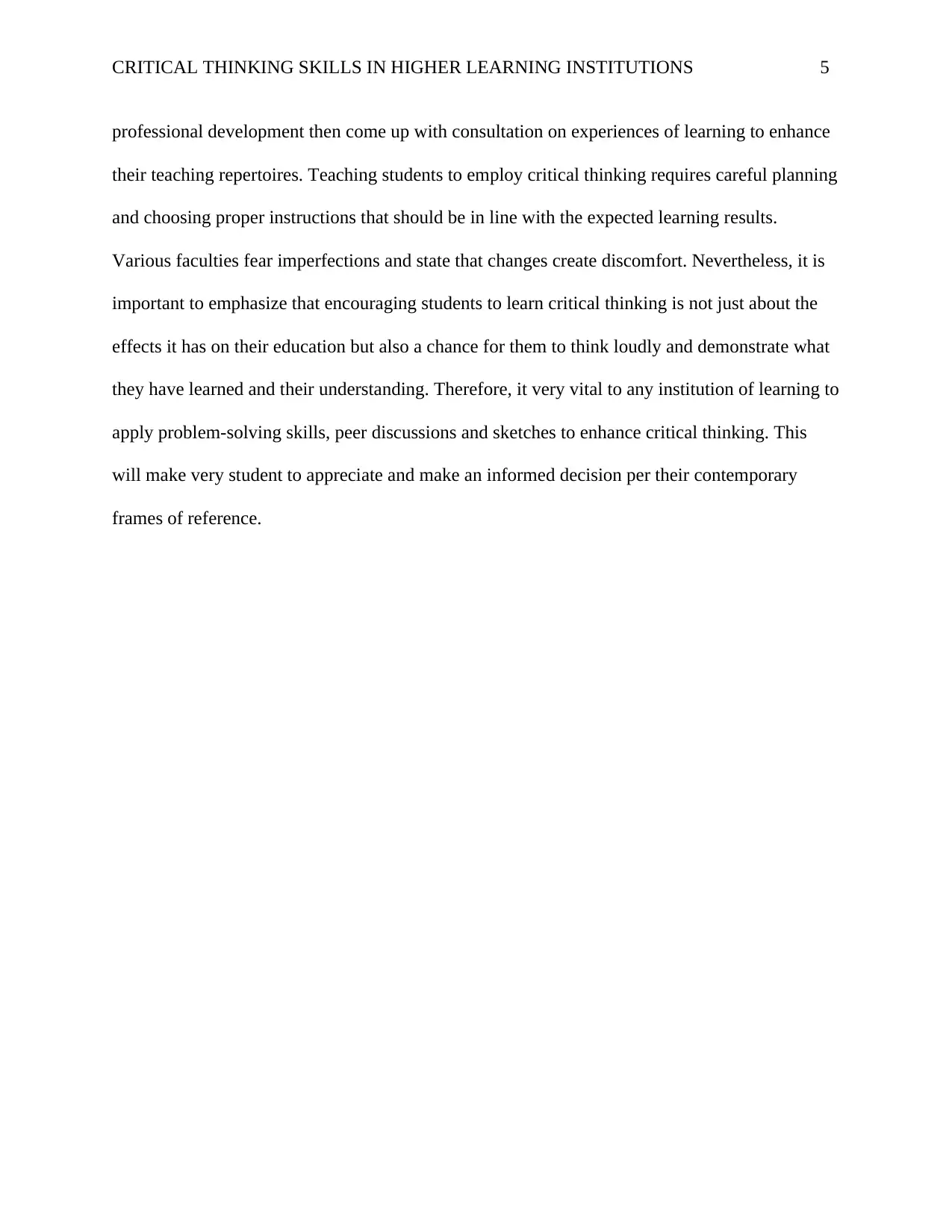
CRITICAL THINKING SKILLS IN HIGHER LEARNING INSTITUTIONS 5
professional development then come up with consultation on experiences of learning to enhance
their teaching repertoires. Teaching students to employ critical thinking requires careful planning
and choosing proper instructions that should be in line with the expected learning results.
Various faculties fear imperfections and state that changes create discomfort. Nevertheless, it is
important to emphasize that encouraging students to learn critical thinking is not just about the
effects it has on their education but also a chance for them to think loudly and demonstrate what
they have learned and their understanding. Therefore, it very vital to any institution of learning to
apply problem-solving skills, peer discussions and sketches to enhance critical thinking. This
will make very student to appreciate and make an informed decision per their contemporary
frames of reference.
professional development then come up with consultation on experiences of learning to enhance
their teaching repertoires. Teaching students to employ critical thinking requires careful planning
and choosing proper instructions that should be in line with the expected learning results.
Various faculties fear imperfections and state that changes create discomfort. Nevertheless, it is
important to emphasize that encouraging students to learn critical thinking is not just about the
effects it has on their education but also a chance for them to think loudly and demonstrate what
they have learned and their understanding. Therefore, it very vital to any institution of learning to
apply problem-solving skills, peer discussions and sketches to enhance critical thinking. This
will make very student to appreciate and make an informed decision per their contemporary
frames of reference.
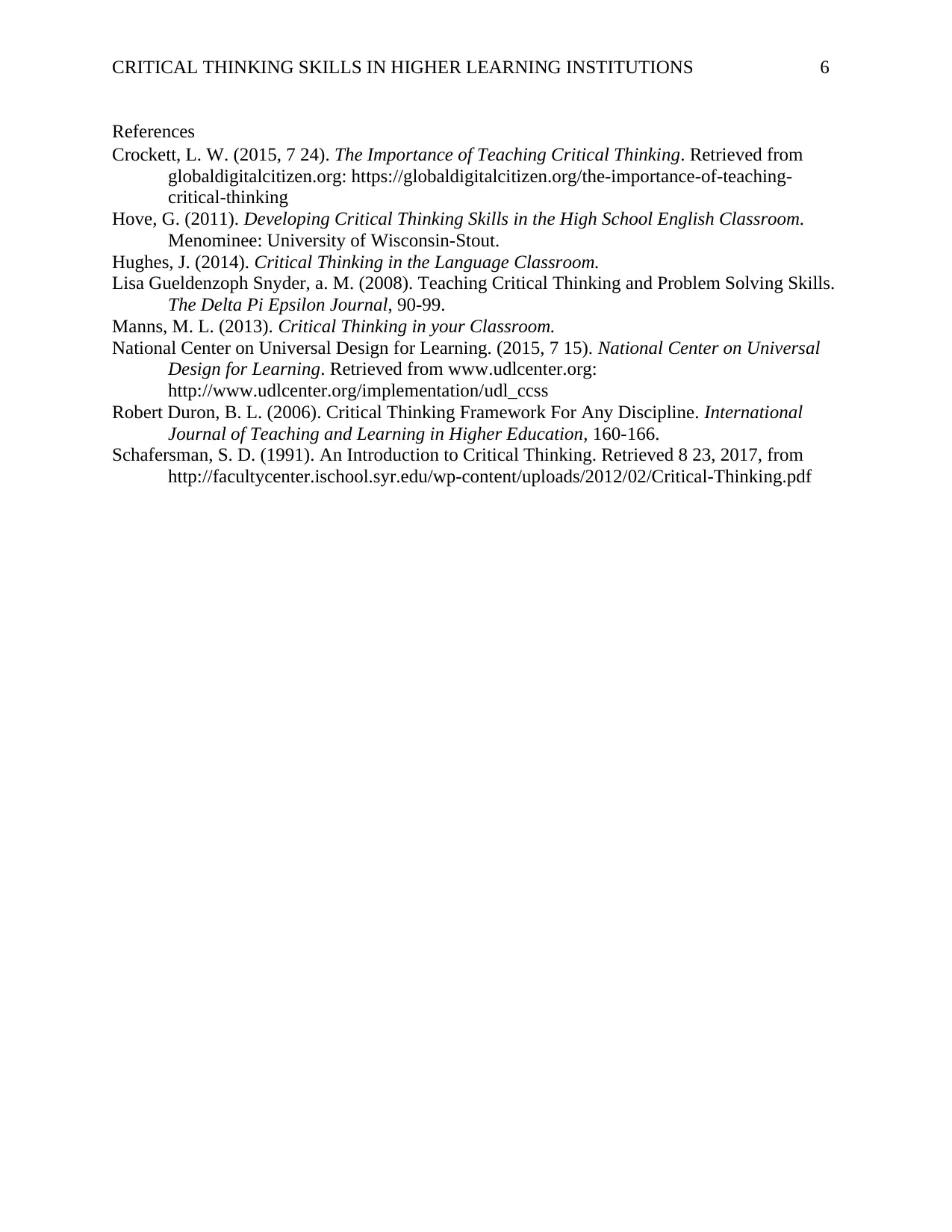
CRITICAL THINKING SKILLS IN HIGHER LEARNING INSTITUTIONS 6
References
Crockett, L. W. (2015, 7 24). The Importance of Teaching Critical Thinking. Retrieved from
globaldigitalcitizen.org: https://globaldigitalcitizen.org/the-importance-of-teaching-
critical-thinking
Hove, G. (2011). Developing Critical Thinking Skills in the High School English Classroom.
Menominee: University of Wisconsin-Stout.
Hughes, J. (2014). Critical Thinking in the Language Classroom.
Lisa Gueldenzoph Snyder, a. M. (2008). Teaching Critical Thinking and Problem Solving Skills.
The Delta Pi Epsilon Journal, 90-99.
Manns, M. L. (2013). Critical Thinking in your Classroom.
National Center on Universal Design for Learning. (2015, 7 15). National Center on Universal
Design for Learning. Retrieved from www.udlcenter.org:
http://www.udlcenter.org/implementation/udl_ccss
Robert Duron, B. L. (2006). Critical Thinking Framework For Any Discipline. International
Journal of Teaching and Learning in Higher Education, 160-166.
Schafersman, S. D. (1991). An Introduction to Critical Thinking. Retrieved 8 23, 2017, from
http://facultycenter.ischool.syr.edu/wp-content/uploads/2012/02/Critical-Thinking.pdf
References
Crockett, L. W. (2015, 7 24). The Importance of Teaching Critical Thinking. Retrieved from
globaldigitalcitizen.org: https://globaldigitalcitizen.org/the-importance-of-teaching-
critical-thinking
Hove, G. (2011). Developing Critical Thinking Skills in the High School English Classroom.
Menominee: University of Wisconsin-Stout.
Hughes, J. (2014). Critical Thinking in the Language Classroom.
Lisa Gueldenzoph Snyder, a. M. (2008). Teaching Critical Thinking and Problem Solving Skills.
The Delta Pi Epsilon Journal, 90-99.
Manns, M. L. (2013). Critical Thinking in your Classroom.
National Center on Universal Design for Learning. (2015, 7 15). National Center on Universal
Design for Learning. Retrieved from www.udlcenter.org:
http://www.udlcenter.org/implementation/udl_ccss
Robert Duron, B. L. (2006). Critical Thinking Framework For Any Discipline. International
Journal of Teaching and Learning in Higher Education, 160-166.
Schafersman, S. D. (1991). An Introduction to Critical Thinking. Retrieved 8 23, 2017, from
http://facultycenter.ischool.syr.edu/wp-content/uploads/2012/02/Critical-Thinking.pdf
⊘ This is a preview!⊘
Do you want full access?
Subscribe today to unlock all pages.

Trusted by 1+ million students worldwide
1 out of 6
Your All-in-One AI-Powered Toolkit for Academic Success.
+13062052269
info@desklib.com
Available 24*7 on WhatsApp / Email
![[object Object]](/_next/static/media/star-bottom.7253800d.svg)
Unlock your academic potential
Copyright © 2020–2025 A2Z Services. All Rights Reserved. Developed and managed by ZUCOL.


